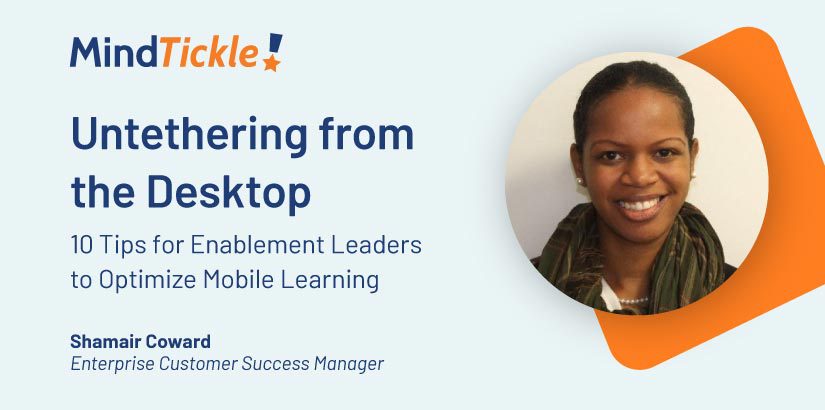A mobile learning culture has never been more important than it is today. Over the last several months, my clients have had to adapt to the enablement and communication needs of a fully remote population. And in that time, the definition of a remote worker has been in a state of change, it’s certainly less traditional than it once was.
I have seen my clients having to accommodate those who now have to support their children with virtual learning activities for school, tackle an increase of duties in and out of the home, and face an overall plethora of added distractions. Moreover, they’re tussling with the fatigue of being behind a laptop for extended amounts of time with little to no external interactions. Thus, when and where it is possible to make a move, they go!
Accordingly, clients have had to adjust their enablement style to become truly mobile. What does it mean to have a truly mobile enablement culture? I’m referring to a methodology that goes beyond the traditional context of “virtual learning.” Rather, it taps into the connotation of 24-7 accessibility, and flexibility that comes with the word “virtual.” Having content readily available on both mobile and desktop sits at the foundation of building out a mobile culture–it certainly accommodates the situations outlined above.
To foster a true mobile learning culture, the content and its delivery platform must address these key types of access with the rep who’s learning in mind – access that they know, access on-the-go, and access in the flow.
- Access that they know. Be sure that the learner is familiar with the tools and the applications that are needed to consume or engage with the content.
- Communicate the name of the platform, its purpose, and how to access the application. I can’t tell you how many times I’ve seen organizations roll out an amazing technology platform and the learners have no idea that it exists! Or better yet, even If there is some faint knowledge of the platform, they have no idea how to access it.
- A brief introduction of the platform(s) can be very helpful. We want to avoid frustration around accessing the platform. Like with most technology, especially applications, if the user experiences difficulties upon initial use, it becomes extremely difficult to re-engage them.
- Sending an introduction video featuring or narrated by a senior leader introducing the platform, a program imitative, and/or a directive is a common practice amongst our clients. The keynote video is usually followed by a series of content orienting the learner to the functionalities of the platform.
- Help your learners to “know” the platforms so that they are comfortable using the platform. This leaves the only thing left to do but learn!
- Access on the go. Be sure that the learner can engage or be engaged with the platform no matter where they are.
- Even prior to COVID-19, flexible work arrangements were growing in popularity amongst organizations around the globe. Now, employees are splitting their work hours between their office and their home. Part of making this transition successful is providing consistent access to all systems and tools. There should be no exception when it comes to a company’s learning platforms.
- A cloud-based platform allows for consistency across platforms. Learners can log-on to their personal desktop, work laptop, personal tablet, or mobile and get the same experience. If you’re anything like me, and the countless learners whose behaviors I’ve come to know quite well, depending on where you’re going determines the device that you will carry along with you. When heading into the office, learners are often hands-free ready to take action via their desktops. While commuting, a tablet or smartphone will do the trick. Even if driving, a cellular Bluetooth connection to the car speakers works wonders for consuming content on the go. A truly mobile experience.
- Access in the flow. Slightly different from “on the go,” in the flow incorporates learning into the end learner’s flow of life.
- Think about the scenarios that your learners will face from day to day, especially in the current times we live in. Many learners are multi-tasking their whole life! With children at home, an increase in chores, doubled grocery runs, consuming content must fit into the rhythm of the day as best as possible.
- Many of my clients develop programming that is high in audio, and visual content. This is quite effective. Imagine the learner preparing dinner and consuming an audio piece of learning content. Thereafter the leaner may decide to relax on the couch and respond to the 2-3 questions added to the tail-end of the video. The learner is naturally moving through the flow of their day, their mobile device is moving along with them.
- In short, I tell my program owners, as much as possible to go with the flow.
Providing users with learning access that they know, learning access on-the-go, and learning access in the flow of life lends to developing a truly mobile culture. To remain competitive in our new reality, we can’t afford to miss the mark by ignoring the high stakes placed on true mobility. It lends to the new world we’ve transitioned into, whether it is here for today or to stay.



 By Kevin Atkinson
By Kevin Atkinson


